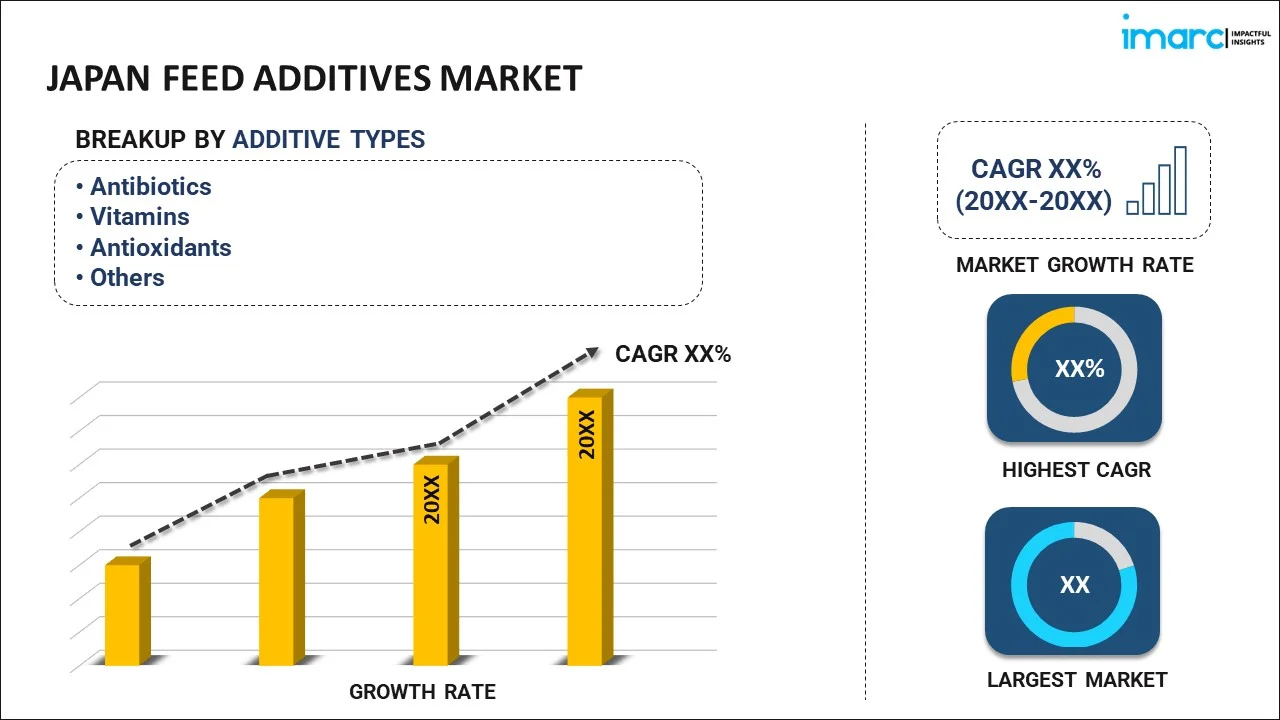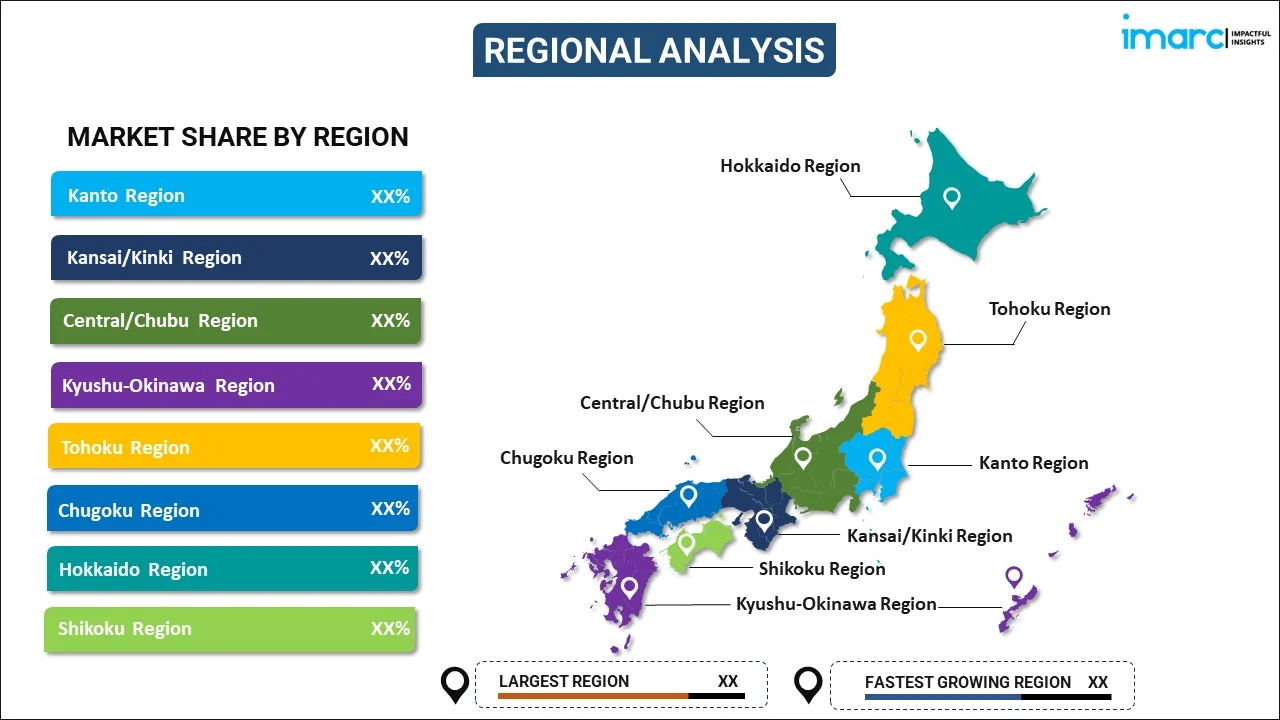
Japan Feed Additives Market Report by Additive Type (Antibiotics, Vitamins, Antioxidants, Amino Acids, Enzymes, Mycotoxin Detoxifiers, Prebiotics, Probiotics, Flavors and Sweeteners, Pigments, Binders, Minerals), Animal Type (Ruminants, Poultry, Swine, Others), and Region 2025-2033
Market Overview:
Japan feed additives market size reached USD 579.7 Million in 2024. Looking forward, IMARC Group expects the market to reach USD 907.1 Million by 2033, exhibiting a growth rate (CAGR) of 4.85% during 2025-2033. The rising concerns among farmers towards animal health and preventing several diseases, along with the expanding aquaculture industry, are primarily augmenting the market growth.
|
Report Attribute
|
Key Statistics
|
|---|---|
|
Base Year
|
2024
|
|
Forecast Years
|
2025-2033
|
|
Historical Years
|
2019-2024
|
| Market Size in 2024 | USD 579.7 Million |
| Market Forecast in 2033 | USD 907.1 Million |
| Market Growth Rate 2025-2033 | 4.85% |
Feed additives are nutritional enhancements given to a range of animals including ruminants, swine, poultry, and aquatic creatures. They are enriched with elements like calcium, beta-carotene, citric acid, sodium, potassium, lactic acid, manganese, and antioxidants. These additives play a crucial role in maintaining animal health, promoting appetite, and warding off various diseases. They contribute to elevating the quality of products derived from animals like meat, milk, and eggs. Additionally, they play a pivotal role in sustaining a balanced nutritional profile in the animal diet and eliminating diverse bacteria within the animal’s body. As such, these additives also fortify the immune system, mitigate stress levels, and support enhanced reproductive capabilities in animals.
Japan Feed Additives Market Trends:
The Japan feed additives market is experiencing substantive growth, reflecting the country’s commitment to advancing animal nutrition and enhancing the quality of animal-derived products. These nutritional supplements, endowed with elements like calcium, beta-carotene, and antioxidants, are integral in ensuring the well-being and optimum health of poultry, swine, and aquatic species. The regional market, with its emphasis on quality and health, is increasingly acknowledging the benefits of feed additives in elevating the standard of products like meat, milk, and eggs. Japan’s robust research and technological advancements in animal nutrition are driving innovations in feed additives, aimed at optimizing the nutritional balance in animal diets and reinforcing their immune systems. Moreover, the regulatory landscape in Japan, characterized by stringent quality and safety standards, is shaping the market dynamics, encouraging the development and adoption of high-quality and efficient nutritional enhancements. The evolving consumer preferences towards healthier and higher-quality animal-derived products are propelling the demand for nutritious and balanced animal feed, subsequently driving the market for feed additives in Japan. The rising interest in sustainable and eco-friendly animal rearing practices further accentuates the market’s growth trajectory, spotlighting the importance of holistic nutritional approaches in animal husbandry.
Japan Feed Additives Market Segmentation:
IMARC Group provides an analysis of the key trends in each segment of the market, along with forecasts at the country level for 2025-2033. Our report has categorized the market based on additive type and animal type.
Additive Type Insights:

- Antibiotics
- Vitamins
- Antioxidants
- Amino Acids
- Enzymes
- Mycotoxin Detoxifiers
- Prebiotics
- Probiotics
- Flavors and Sweeteners
- Pigments
- Binders
- Minerals
The report has provided a detailed breakup and analysis of the market based on the additive type. This includes antibiotics, vitamins, antioxidants, amino acids, enzymes, mycotoxin detoxifiers, prebiotics, probiotics, flavors and sweeteners, pigments, binders, and minerals.
Animal Type Insights:
- Ruminants
- Poultry
- Swine
- Others
A detailed breakup and analysis of the market based on the animal type have also been provided in the report. This includes ruminants, poultry, swine, and others.
Regional Insights:

- Kanto Region
- Kansai/Kinki Region
- Central/ Chubu Region
- Kyushu-Okinawa Region
- Tohoku Region
- Chugoku Region
- Hokkaido Region
- Shikoku Region
The report has also provided a comprehensive analysis of all the major regional markets, which include Kanto Region, Kansai/Kinki Region, Central/ Chubu Region, Kyushu-Okinawa Region, Tohoku Region, Chugoku Region, Hokkaido Region, and Shikoku Region.
Competitive Landscape:
The market research report has also provided a comprehensive analysis of the competitive landscape. Competitive analysis such as market structure, key player positioning, top winning strategies, competitive dashboard, and company evaluation quadrant has been covered in the report. Also, detailed profiles of all major companies have been provided.
Japan Feed Additives Market Report Coverage:
| Report Features | Details |
|---|---|
| Base Year of the Analysis | 2024 |
| Historical Period | 2019-2024 |
| Forecast Period | 2025-2033 |
| Units | Million USD |
| Scope of the Report | Exploration of Historical and Forecast Trends, Industry Catalysts and Challenges, Segment-Wise Historical and Predictive Market Assessment:
|
| Additive Types Covered | Antibiotics, Vitamins, Antioxidants, Amino Acids, Enzymes, Mycotoxin Detoxifiers, Prebiotics, Probiotics, Flavors and Sweeteners, Pigments, Binders, Minerals |
| Animal Types Covered | Ruminants, Poultry, Swine, Others |
| Regions Covered | Kanto Region, Kansai/Kinki Region, Central/ Chubu Region, Kyushu-Okinawa Region, Tohoku Region, Chugoku Region, Hokkaido Region, Shikoku Region |
| Customization Scope | 10% Free Customization |
| Post-Sale Analyst Support | 10-12 Weeks |
| Delivery Format | PDF and Excel through Email (We can also provide the editable version of the report in PPT/Word format on special request) |
Key Questions Answered in This Report:
- How has the Japan feed additives market performed so far and how will it perform in the coming years?
- What has been the impact of COVID-19 on the Japan feed additives market?
- What is the breakup of the Japan feed additives market on the basis of additive type?
- What is the breakup of the Japan feed additives market on the basis of animal type?
- What are the various stages in the value chain of the Japan feed additives market?
- What are the key driving factors and challenges in the Japan feed additives?
- What is the structure of the Japan feed additives market and who are the key players?
- What is the degree of competition in the Japan feed additives market?
Key Benefits for Stakeholders:
- IMARC’s industry report offers a comprehensive quantitative analysis of various market segments, historical and current market trends, market forecasts, and dynamics of the Japan feed additives market from 2019-2033.
- The research report provides the latest information on the market drivers, challenges, and opportunities in the Japan feed additives market.
- Porter's five forces analysis assist stakeholders in assessing the impact of new entrants, competitive rivalry, supplier power, buyer power, and the threat of substitution. It helps stakeholders to analyze the level of competition within the Japan feed additives industry and its attractiveness.
- Competitive landscape allows stakeholders to understand their competitive environment and provides an insight into the current positions of key players in the market.
Need more help?
- Speak to our experienced analysts for insights on the current market scenarios.
- Include additional segments and countries to customize the report as per your requirement.
- Gain an unparalleled competitive advantage in your domain by understanding how to utilize the report and positively impacting your operations and revenue.
- For further assistance, please connect with our analysts.
 Inquire Before Buying
Inquire Before Buying
 Speak to an Analyst
Speak to an Analyst
 Request Brochure
Request Brochure
 Request Customization
Request Customization




.webp)




.webp)












